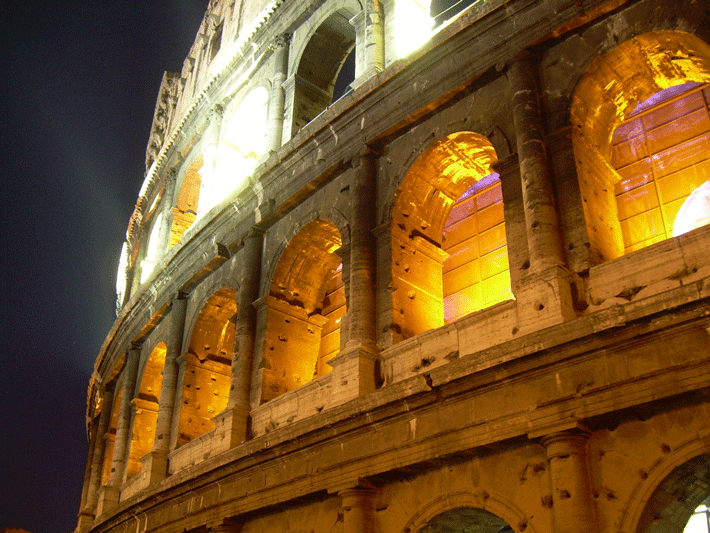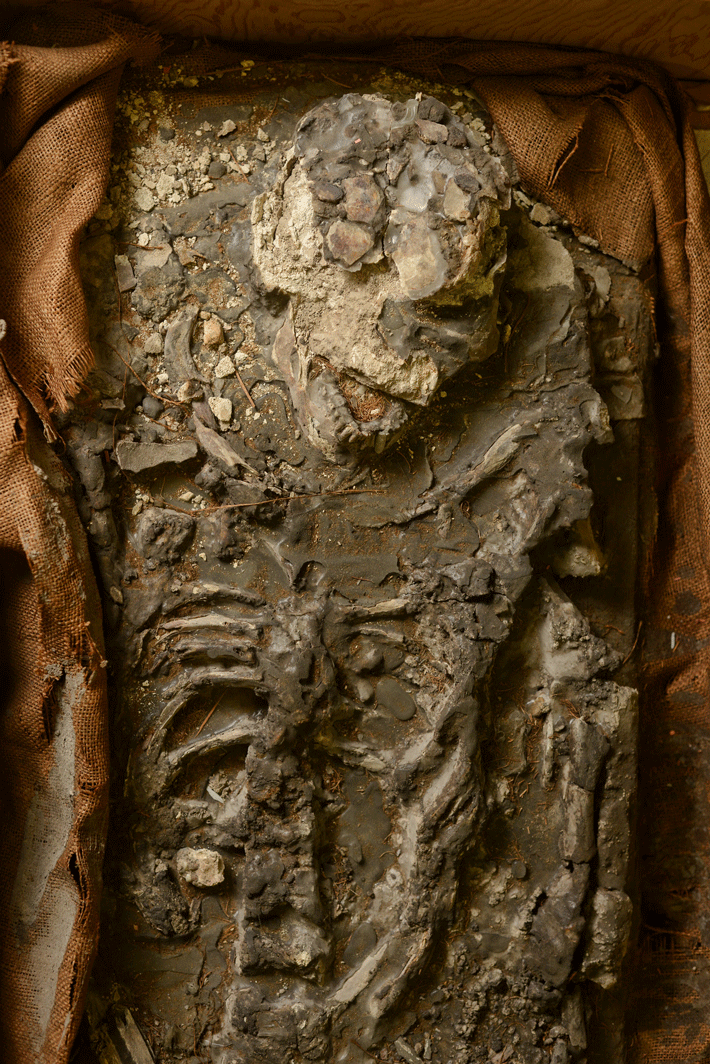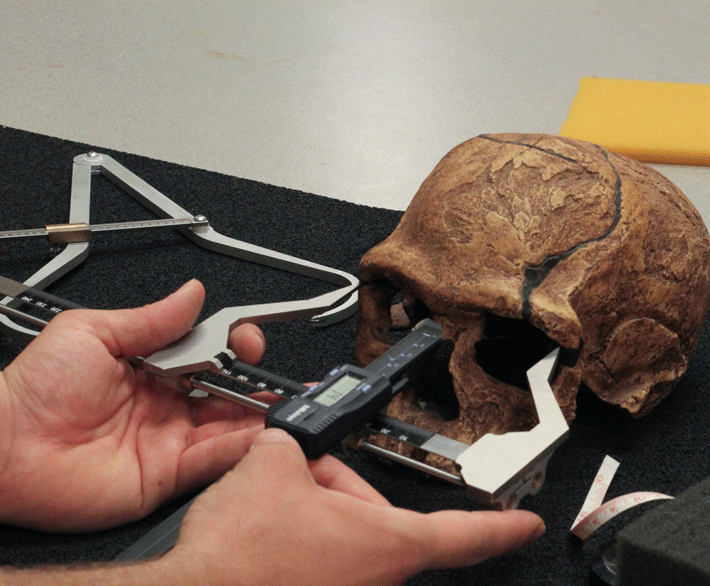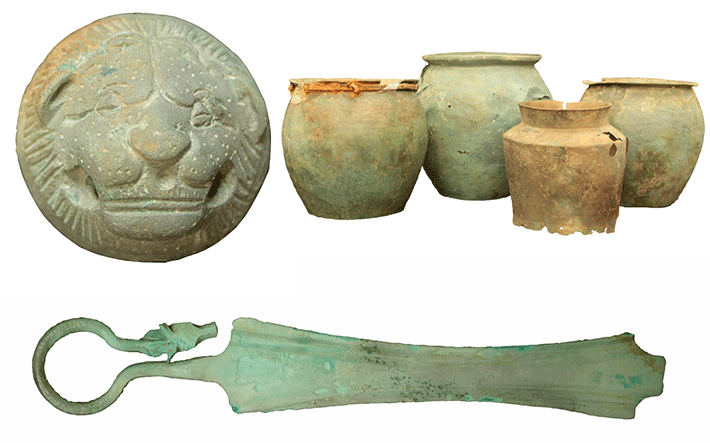From The Trenches
Colosseum Condos
By JASON URBANUS
Tuesday, October 14, 2014
 The Flavian amphitheater, better known as the Colosseum, was one of the Roman Empire’s architectural wonders, and perhaps its most infamous address. Home to gladiatorial fights, wild animal hunts, and even the occasional naval battle, the edifice hosted Rome’s greatest spectacles. With a seating capacity of up to 50,000 spectators, the arena had many as 80 arched entrances to facilitate the traffic of its large crowds. However, a recent three-week excavation conducted by Roma Tre University and the American University of Rome beneath those entryways has revealed new evidence about the time, between the ninth and fourteenth centuries, when the Colosseum was home to more ordinary Roman citizens. After the collapse of the Roman Empire, local friars who controlled the property rented out the space and transformed the Colosseum into a makeshift condominium complex. Stables, workshops, and private residences lined the communal courtyard, creating a kind of medieval bazaar where bloody contests once took place. Archaeologists have uncovered terracotta sewage pipes, cookware, and a carved ivory monkey figurine, likely used as a gaming piece. The Colosseum functioned in this capacity until 1349, when an earthquake struck Rome and rendered the building architecturally unsound.
The Flavian amphitheater, better known as the Colosseum, was one of the Roman Empire’s architectural wonders, and perhaps its most infamous address. Home to gladiatorial fights, wild animal hunts, and even the occasional naval battle, the edifice hosted Rome’s greatest spectacles. With a seating capacity of up to 50,000 spectators, the arena had many as 80 arched entrances to facilitate the traffic of its large crowds. However, a recent three-week excavation conducted by Roma Tre University and the American University of Rome beneath those entryways has revealed new evidence about the time, between the ninth and fourteenth centuries, when the Colosseum was home to more ordinary Roman citizens. After the collapse of the Roman Empire, local friars who controlled the property rented out the space and transformed the Colosseum into a makeshift condominium complex. Stables, workshops, and private residences lined the communal courtyard, creating a kind of medieval bazaar where bloody contests once took place. Archaeologists have uncovered terracotta sewage pipes, cookware, and a carved ivory monkey figurine, likely used as a gaming piece. The Colosseum functioned in this capacity until 1349, when an earthquake struck Rome and rendered the building architecturally unsound.
North Dakota's Archaeology Boom
By DANIEL WEISS
Tuesday, October 14, 2014
 An oil boom in North Dakota has pushed production to more than a million barrels per day, brought a flood of workers to the state—and put some residents’ nerves on edge. At the same time, it has produced plenty of new work for archaeologists as surveys are triggered to ensure that no important cultural features are damaged by development.
An oil boom in North Dakota has pushed production to more than a million barrels per day, brought a flood of workers to the state—and put some residents’ nerves on edge. At the same time, it has produced plenty of new work for archaeologists as surveys are triggered to ensure that no important cultural features are damaged by development.
A survey is only formally required when the federal government helps fund the project or owns at least part of the development site or its mineral rights, and in certain cases under state law. Sometimes, though, developers commission surveys on their own to demonstrate goodwill and protect themselves in case of future disputes.
The acreage covered by these surveys more than doubled between 2008 and 2013. As a result, archaeologists have unearthed everything from abandoned farmsteads to colonial cemeteries, Native American stone circles, and tools made from Knife River flint, which was harvested from a quarry in the state at least as early as 10,000 years ago and was traded from coast to coast.
“One of North Dakota’s first natural resources wasn’t oil,” says Aaron Barth, an archaeologist conducting surveys in the state for KLJ Engineering. “It was actually Knife River flint. Stone tools, scrapers, you name it, anything to cut with was made from it.”
As inquiries from land speculators have become more insistent, some residents have taken their hostility out on archaeologists. In many cases, though, their irascibility gives way to curiosity when archaeologists explain the purpose of their surveys.
“Over half the time when someone comes out initially angry, and we say that we’re archaeologists there to make sure unique cultural resources are protected,” says archaeologist Jessica Bush, cultural resource work group manager with KLJ Engineering, “their mood completely changes. They’ll say, ‘I know this great stone circle.’”
Storeroom Surprise
By JASON URBANUS
Tuesday, October 14, 2014
 As they digitized old records over the last two years, researchers at the University of Pennsylvania Museum of Archaeology and Anthropology unexpectedly solved one of the museum’s great mysteries—the origin of a 6,500-year-old skeleton lying in one of their storerooms.
As they digitized old records over the last two years, researchers at the University of Pennsylvania Museum of Archaeology and Anthropology unexpectedly solved one of the museum’s great mysteries—the origin of a 6,500-year-old skeleton lying in one of their storerooms.
Between 1922 and 1934, Sir Leonard Woolley excavated the Sumerian site of Ur in southern Iraq, including dozens of burials. Much of the material uncovered was divided between the Penn Museum and the British Museum, and some time around 1930, the Penn Museum received a box containing a skeleton from the Ur excavations. Over the decades, however, all documentation relating to the container was lost, and the remains lay anonymously in museum storage for 85 years.
As part of the digitizing project, researchers were led to Woolley’s notebooks, which they used to connect their unidentified skeleton with a grave excavated by Woolley in 1930. It was an easy match, as the archaeologist had lifted the bones and the surrounding deposit as a whole, and then coated them in wax. According to Penn curator Janet Monge, the remains belonged to a muscular male in his 50s who stood about five feet nine inches tall. He had been buried with his legs extended, his arms lying at his sides, and his hands resting on his abdomen. Woolley recorded that the man was found in one of the earliest levels of Ur, in a layer of silt deposited by a great flood, leading some of the researchers to nickname the remains “Noah.” A complete skeleton more than six millennia old is extremely rare, and the museum is hoping that new technologies will provide valuable information about a little-known culture, as well as indications of the man’s diet, ancestral origins, and cause of death.
Hormones and Hominins
By ZACH ZORICH
Tuesday, October 14, 2014
 Around 80,000 to 30,000 years ago, what we now recognize as modern human culture was taking shape. Homo sapiens was migrating out of Africa, creating symbolic artwork, and inventing new stone tools—changes that are often attributed to the evolution of large brains. But what if loads of brain matter alone weren’t enough to give rise to human culture? A new study by a research team that includes Robert Cieri, a doctoral student at the University of Utah, makes such an argument. Their work shows that, over time, humans evolved to produce less testosterone, which made them less prone to aggression and more socially tolerant—all of which set the stage for cultural advances. “It’s important to realize that much of our success in the last 200,000 years really has to do with our social skills,” says Cieri.
Around 80,000 to 30,000 years ago, what we now recognize as modern human culture was taking shape. Homo sapiens was migrating out of Africa, creating symbolic artwork, and inventing new stone tools—changes that are often attributed to the evolution of large brains. But what if loads of brain matter alone weren’t enough to give rise to human culture? A new study by a research team that includes Robert Cieri, a doctoral student at the University of Utah, makes such an argument. Their work shows that, over time, humans evolved to produce less testosterone, which made them less prone to aggression and more socially tolerant—all of which set the stage for cultural advances. “It’s important to realize that much of our success in the last 200,000 years really has to do with our social skills,” says Cieri.
In addition to making people aggressive, testosterone affects the way human skulls grow, and this factor was key in the research. High testosterone levels are associated with thicker brow ridges and other facial traits. Cieri’s group compared measurements from the skulls of ancient humans—dating to as early as 200,000 years ago—with those of modern Homo sapiens. They found that nearly all the skulls belonging to people who lived more than 80,000 years ago show evidence of testosterone levels that were far higher than any modern-day human’s. These high hormone levels may have made social cooperation and community-building more difficult. By contrast, the more recent skulls have traits that indicate lower testosterone levels, which may have allowed ancient humans to live together in larger groups and interact peacefully with outsiders, thus facilitating cultural exchange and advancing technological innovation. In a world that was becoming more crowded, those who had the traits that permitted them to adapt would be more successful, and therefore would pass the traits for lower testosterone and increased social cooperation on to their offspring. “You could see it as people becoming adapted to a new ecology,” Cieri says.
Fifteen Centuries of Life in Chianti
By JASON URBANUS
Tuesday, October 14, 2014

The excavation of an ancient well in Cetamura del Chianti, Italy, has yielded a veritable treasure trove of information about the site’s Etruscan, Roman, and medieval inhabitants. Over the last four years, archaeologists led by Florida State University’s Nancy de Grummond have retrieved thousands of artifacts spanning 15 centuries—generally well preserved by the watery setting—from the 105-foot-deep well. Many of the objects, including hundreds of votive cups, animal bones, and coins, were intentionally thrown into the well as part of sacred and ritual activity. Among the numerous metal objects recovered are at least 14 bronze Etruscan and Roman water vessels, some finely decorated with mythological creatures. The waterlogged environment also preserved wood and even grape seeds. Researchers are hoping to analyze the seeds’ DNA to further understand the composition of ancient wine, and to match the seeds with modern grape varieties. Says de Grummond, “This rich assemblage of materials in bronze, silver, lead, and iron, along with the abundant ceramics and remarkable evidence of organic remains, creates an unparalleled opportunity for the study of culture, religion, and daily life in Chianti and the surrounding region.”
Advertisement
Advertisement
IN THIS ISSUE
Features
Dawn of a Thousand Suns
The Neolithic Toolkit
The Ongoing Saga of Sutton Hoo
Letter From Montana
Advertisement

Recent Issues
-
 May/June 2024
May/June 2024
-
 March/April 2024
March/April 2024
-
 January/February 2024
January/February 2024
-
 November/December 2023
November/December 2023
-
 September/October 2023
September/October 2023
-
 July/August 2023
July/August 2023
-
 May/June 2023
May/June 2023
-
 March/April 2023
March/April 2023
-
 January/February 2023
January/February 2023
-
 November/December 2022
November/December 2022
-
 September/October 2022
September/October 2022
-
 July/August 2022
July/August 2022
-
 May/June 2022
May/June 2022
-
 March/April 2022
March/April 2022
-
 January/February 2022
January/February 2022
-
 November/December 2021
November/December 2021
-
 September/October 2021
September/October 2021
-
 July/August 2021
July/August 2021
-
 May/June 2021
May/June 2021
-
 March/April 2021
March/April 2021
-
 January/February 2021
January/February 2021
-
 November/December 2020
November/December 2020
-
 September/October 2020
September/October 2020
-
 July/August 2020
July/August 2020
-
 May/June 2020
May/June 2020
-
 March/April 2020
March/April 2020
-
 January/February 2020
January/February 2020
-
 November/December 2019
November/December 2019
-
 September/October 2019
September/October 2019
-
 July/August 2019
July/August 2019
-
 May/June 2019
May/June 2019
-
 March/April 2019
March/April 2019
-
 January/February 2019
January/February 2019
-
 November/December 2018
November/December 2018
-
 September/October 2018
September/October 2018
-
 July/August 2018
July/August 2018
-
 May/June 2018
May/June 2018
-
 March/April 2018
March/April 2018
-
 January/February 2018
January/February 2018
-
 November/December 2017
November/December 2017
-
 September/October 2017
September/October 2017
-
 July/August 2017
July/August 2017
-
 May/June 2017
May/June 2017
-
 March/April 2017
March/April 2017
-
 January/February 2017
January/February 2017
-
 November/December 2016
November/December 2016
-
 September/October 2016
September/October 2016
-
 July/August 2016
July/August 2016
-
 May/June 2016
May/June 2016
-
 March/April 2016
March/April 2016
-
 January/February 2016
January/February 2016
-
 November/December 2015
November/December 2015
-
 September/October 2015
September/October 2015
-
 July/August 2015
July/August 2015
-
 May/June 2015
May/June 2015
-
 March/April 2015
March/April 2015
-
 January/February 2015
January/February 2015
-
 November/December 2014
November/December 2014
-
 September/October 2014
September/October 2014
-
 July/August 2014
July/August 2014
-
 May/June 2014
May/June 2014
-
 March/April 2014
March/April 2014
-
 January/February 2014
January/February 2014
-
 November/December 2013
November/December 2013
-
 September/October 2013
September/October 2013
-
 July/August 2013
July/August 2013
-
 May/June 2013
May/June 2013
-
 March/April 2013
March/April 2013
-
 January/February 2013
January/February 2013
-
 November/December 2012
November/December 2012
-
 September/October 2012
September/October 2012
-
 July/August 2012
July/August 2012
-
 May/June 2012
May/June 2012
-
 March/April 2012
March/April 2012
-
 January/February 2012
January/February 2012
-
 November/December 2011
November/December 2011
-
 September/October 2011
September/October 2011
-
 July/August 2011
July/August 2011
-
 May/June 2011
May/June 2011
-
 March/April 2011
March/April 2011
-
 January/February 2011
January/February 2011
Advertisement






